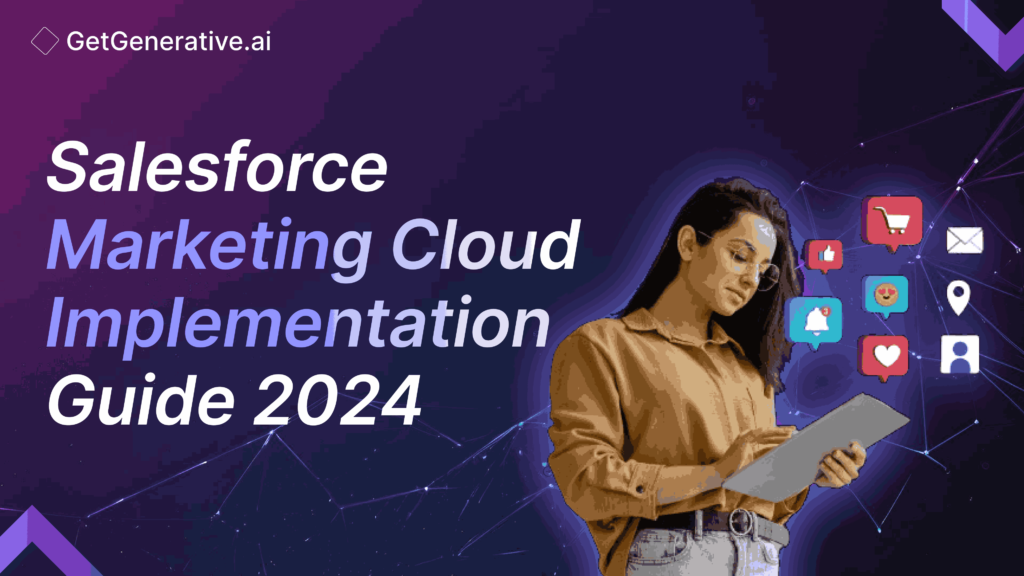Salesforce Marketing Cloud Implementation Guide 2024
In today’s digital landscape, businesses constantly seek ways to enhance their marketing efforts and engage with customers more effectively. According to a report by Salesforce, 84% of customers say the company’s experience is as important as its products and services.
Additionally, a study by Forrester found that companies that excel at marketing automation generate 50% more sales-ready leads at a 33% lower cost. Salesforce Marketing Cloud (SFMC) has emerged as a powerful platform that enables companies to create, manage, and automate their marketing campaigns across multiple channels.
In this blog post, we’ll dive into the Salesforce Marketing Cloud implementation world, exploring its features, benefits, and best practices.
What is Salesforce Marketing Cloud?
Salesforce Marketing Cloud (SFMC) is a powerful digital marketing platform that enables businesses to create, manage, and automate marketing campaigns across multiple channels. It provides a comprehensive suite of tools and features to help marketers deliver personalized and engaging customer experiences.
One key aspect of SFMC is its ability to unify customer data from various sources, such as email interactions, social media engagement, and website behavior. By consolidating this data into a single platform, marketers can gain a holistic view of their customers and create targeted segments based on demographics, interests, and behaviors.
How to Implement Salesforce Marketing Cloud
Implementing Salesforce Marketing Cloud (SFMC) involves several key steps to ensure successful deployment and optimal platform utilization. Here’s a detailed breakdown of the implementation process:
Define your marketing strategy:
- Identify your marketing goals and objectives. What do you aim to achieve with SFMC?
- Define your target audience and create detailed buyer personas to guide your marketing efforts.
- Determine the key performance indicators (KPIs) you will use to measure the success of your marketing campaigns.
- Document your overall marketing strategy, including the channels you plan to utilize and the types of campaigns you intend to run.
Set up your account:
- Work with Salesforce to create your SFMC account and obtain the necessary login credentials.
- Configure user roles and permissions within the platform to ensure appropriate access levels for your team members.
- Set up your branding elements, such as logos and color schemes, to maintain consistency across your marketing communications.
- Configure your account settings, including your sending domain, reply-to address, and unsubscribe settings.
Integrate with data sources:
- Identify the data sources you need to integrate with SFMC, such as your CRM (e.g., Salesforce Sales Cloud), e-commerce platform, or website analytics tool.
- Determine the data fields you want to sync between SFMC and your other systems to ensure a comprehensive view of your customers.
- Set up data extensions in SFMC to store and manage your customer data effectively.
- Implement data import processes to regularly update your SFMC data extensions with the latest customer information.
Build your content:
- Create a content strategy that aligns with your marketing goals and target audience preferences.
- Design responsive email templates using SFMC’s drag-and-drop email builder or coding your HTML templates.
- Develop engaging landing pages to drive conversions and capture lead information.
- Create a library of marketing assets, such as images, videos, and downloadable content, for your campaigns.
- Implement dynamic email content blocks to personalize the content based on subscriber attributes and behaviors.
Segment your audience:
- Analyze your customer data to identify key segmentation criteria, such as demographics, interests, purchase history, or engagement levels.
- Create targeted subscriber lists in SFMC based on your segmentation criteria to ensure relevant and personalized communications.
- Use SFMC’s filtering and segmentation tools to create dynamic segments that automatically update based on real-time customer data.
- Develop a strategy for managing and maintaining your subscriber lists over time, including list hygiene practices and re-engagement campaigns.
Related Read – Salesforce Implementation With AI Guide
Automate your campaigns:
- Utilize SFMC’s Journey Builder to create automated, multi-step customer journeys based on specific triggers and actions.
- Define the entry criteria for each journey, such as a new subscriber sign-up or a specific product purchase.
- Map out the desired flow of communications and interactions within each journey, including email sends, wait periods, and decision splits.
- Implement personalization and dynamic content within your automated campaigns to deliver tailored experiences to each customer.
- Set up error handling and fallback paths to ensure a smooth customer experience even if certain actions fail.
Analyze and optimize:
- Set up tracking and reporting in SFMC to monitor the performance of your marketing campaigns.
- Review key metrics regularly, such as email open rates, click-through rates, conversion rates, and revenue generated.
- Use SFMC’s Analytics Builder to create customized reports and dashboards that provide insights into your marketing performance.
- Conduct A/B testing of your email subject lines, content, and calls to action to identify what resonates best with your audience.
- Continuously iterate and optimize your campaigns based on the insights gained from your analysis to improve performance over time.
Core Components of Salesforce Marketing Cloud
Email Studio:
- Create professional and responsive email templates using the drag-and-drop email builder or custom HTML.
- Personalize email content using subscriber data, such as name, location, or past purchase history.
- Utilize dynamic content blocks to display different content variations based on subscriber attributes or preferences.
- Set up triggered email campaigns based on specific subscriber actions, such as abandoned cart reminders or welcome series.
- Conduct A/B testing on email subject lines, content, or send times to optimize email performance.
- Manage email deliverability by monitoring sender reputation, bounce rates, and spam complaints.
- Comply with legal requirements, such as the CAN-SPAM Act, by including unsubscribe links and physical mailing addresses.
Mobile Studio:
- Send targeted SMS and MMS messages to subscribers who have opted-in to receive mobile communications.
- Create mobile-specific landing pages optimized for smaller screens and touch-based interactions.
- Implement mobile push notifications to engage app users with timely and relevant content.
- Utilize geo-targeting capabilities to send location-based mobile messages or offers.
- Integrate with mobile wallet platforms like Apple Wallet or Google Pay to deliver mobile coupons or loyalty cards.
- Track and analyze mobile campaign performance metrics, such as SMS delivery, click-through, and conversion rates.
Social Studio:
- Monitor and manage multiple social media accounts from a single interface, including Facebook, Twitter, Instagram, and LinkedIn.
- Schedule and publish social media posts across various platforms, ensuring consistent brand messaging.
- Engage with followers by directly responding to comments, messages, and mentions within Social Studio.
- Track social media metrics, such as reach, engagement, and sentiment, to measure the impact of your social campaigns.
- Set up social listening rules to monitor keywords, hashtags, or competitor mentions and gain valuable insights.
- Collaborate with team members by assigning tasks, approving content, and sharing social media assets.
Advertising Studio:
- Created and managed digital advertising campaigns across platforms like Google Ads, Facebook Ads, and LinkedIn Ads.
- Leverage SFMC’s customer data to build targeted ad audiences based on demographics, interests, or behaviors.
- Utilize lookalike audiences to reach new prospects who share similar characteristics with your existing customers.
- Implement retargeting campaigns to re-engage website visitors or users who have shown interest in your products or services.
- Optimize ad performance by conducting A/B testing on ad copy, images, or targeting parameters.
- Track and measure advertising metrics, such as impressions, clicks, cost-per-click (CPC), and return on ad spend (ROAS).
Also Read – Salesforce B2B Commerce Implementation Guide
Journey Builder:
- Create and automate multi-channel customer journeys based on specific triggers or events.
- Define journey entry points like website visits, form submissions, or product purchases.
- You can drag and drop various activity types, such as email sends, wait periods, decision splits, or data updates, to build the desired journey flow.
- Implement personalization within journeys, using customer data to deliver tailored content and experiences.
- Set up journey goals and exit criteria to measure each journey’s success and identify improvement areas.
- Analyze journey performance metrics, such as conversion rates, time spent in each stage, and overall ROI.
Data Studio:
- Integrate and consolidate customer data from various sources, such as SFMC, Salesforce CRM, or external databases.
- Create and manage data extensions to store and organize customer data within SFMC.
- Implement data import and export processes to keep your data up-to-date and synchronized across systems.
- Utilize data segmentation tools to create targeted subscriber lists based on specific criteria or behaviors.
- Leverage data analytics and reporting capabilities to gain insights into customer preferences, campaign performance, and marketing ROI.
- Ensure data quality and integrity by implementing data validation rules, cleansing processes, and governance practices.
Integrating SFMC with Salesforce CRM
One of the key advantages of Salesforce Marketing Cloud is its seamless integration with Salesforce CRM. By connecting SFMC with your Salesforce CRM, you can:
- Sync customer data between the two platforms for a unified view of your customers.
- Trigger marketing campaigns based on customer actions and behaviors in Salesforce CRM.
- Personalize marketing messages using data from Salesforce CRM.
- Measure the impact of your marketing efforts on sales and revenue.
Comparing SFMC with Other Marketing Automation Platforms
When considering Salesforce Marketing Cloud, it’s important to compare it with other leading marketing automation platforms, such as Adobe Marketing Cloud and Oracle Marketing Cloud. Here are some key strengths and weaknesses of SFMC:
Strengths:
- Tight integration with Salesforce CRM
- Robust email marketing capabilities
- Comprehensive social media management tools
- Advanced automation and personalization features
Weaknesses:
- Steeper learning curve compared to some other platforms
- Higher cost compared to some competitors
- Limited built-in content management capabilities
Also Read – Salesforce CPQ Implementation Guide
Conclusion
Salesforce Marketing Cloud implementation offers businesses a robust solution for creating, managing, and automating their marketing campaigns across multiple channels. By leveraging SFMC’s core components, integrating with Salesforce CRM, and following best practices for implementation, companies can enhance their marketing efforts, improve customer engagement, and drive business growth.
To learn more, visit getgenerativeai.com today.
Frequently Asked Questions (FAQs)
1. What is the pricing model for Salesforce Marketing Cloud?
SFMC offers various pricing options based on the specific components and features required. Contact Salesforce for a customized quote.
2. How long does it typically take to implement Salesforce Marketing Cloud?
The implementation timeline varies depending on the complexity of your marketing needs and the project’s scope. It can range from a few weeks to several months.
3. Can Salesforce Marketing Cloud integrate with third-party tools and platforms?
Yes, SFMC offers various integrations with popular third-party tools and platforms like Google Analytics, Slack, and Zapier.
4. Is technical expertise required to use Salesforce Marketing Cloud?
While some technical knowledge can be beneficial, SFMC provides a user-friendly interface and extensive documentation to help marketers navigate the platform effectively.
5. What support and resources are available for Salesforce Marketing Cloud users?
Salesforce offers comprehensive documentation, online training, and a community forum to support SFMC users. Additionally, Salesforce partners and certified consultants can provide implementation and ongoing support services.


